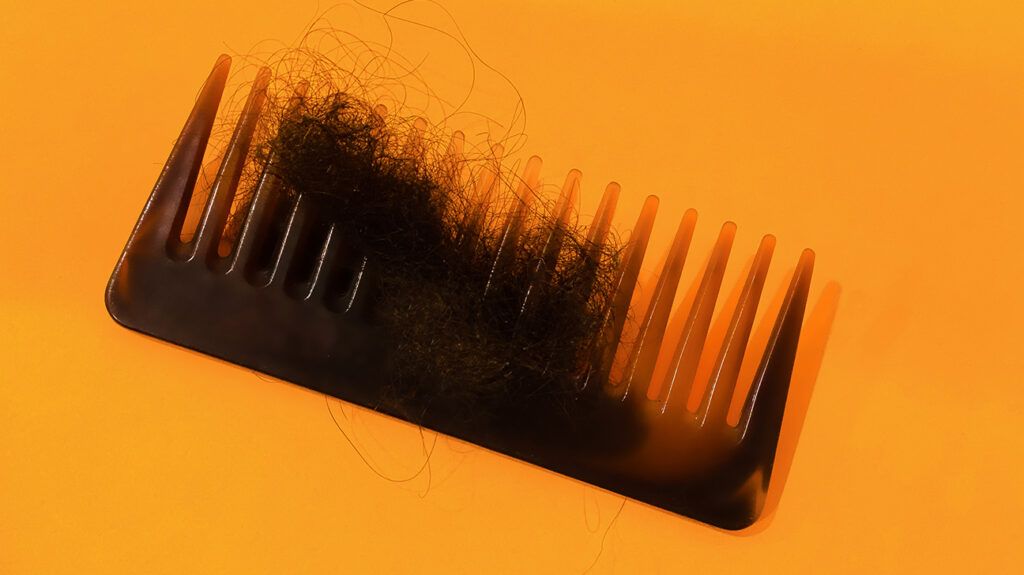Believe it or not, losing 100 hairs a day is typical. But what’s going on when you have 30% or more hair loss in a short span?

If you’ve had acute stress, about 2 to 3 months later, you may notice rapid and intense hair shedding. It’s natural to be concerned, but knowing a few facts about telogen effluvium may reassure you.
A shock to your system, including a stressful event or season, can cause hair loss.
Stressful events and hair loss
If you’re seeing large clumps of hair on your pillow, you may find it beneficial to think back
- childbirth
- intense psychological stress (such as a breakup or job loss)
- major surgery
- serious illness
- possibly having had COVID-19
New York doctors presented a
Ongoing stress factors leading to hair loss
Ongoing stress factors may be harder to pin down but may also contribute to hair loss. These include:
- nutritional deficiencies
- thyroid disease
- chronic illnesses
- marital strain, according to this study
- medications — such as antidepressants
Telogen effluvium explained
The typical hair cycle is known to have four phases:
- growth (anagen phase)
- transitional (catagen phase)
- resting (telogen phase)
- shedding (exogen phase)
Sometimes, due to a shock to the system, the hair’s growth phase stalls out. Telogen effluvium develops when more follicles than usual, at least 30%, don’t properly transition to the resting phase.
Telogen effluvium is the most common form of hair loss, or alopecia. Because it’s a condition of the scalp, if you notice rapid hair loss, you may wish to see a dermatologist for an evaluation.
A
It can be reassuring to learn a few facts about telogen effluvium.
Q: Will it grow back?
A: Once you’ve managed or moved past the stressors, the full follicle cycle of hair growth typically returns.
Q: How do I stop hair loss from stress?
A: While you can’t stop hair loss from stress, you may find it beneficial to work with your dermatologist to determine the source of stress. If they have ruled out all other dermatological or medical causes, and it seems to be mental strain, a therapist can help manage stress.
Q: How long does hair fall out due to stress?
A: Usually, it takes about 2 months after a stressful incident for hair to begin falling out. Telogen effluvium usually lasts about 6 months.
If your hair continues to fall out in clumps after 6 months, you may have more than 1 underlying factor or a chronic condition.
Usually, you can expect to have your typical head of hair back in about 1 year after the telogen effluvium starts.
Q: What hair loss from stress looks like?
A: Dr. Anne Marie McNeill, a California-based board certified dermatologist, observes that while “the overall mechanism of [telogen effluvium] is the same in all hair types,” the way it appears may be different depending on whether your hair is fine and straight, or wavy, coiled, or curly.”
If you have fine or straight hair, you might “tend to notice [telogen effluvium] very quickly” because your hair “is already thin and now looks thinner,” McNeill explains.
If you have wavy, coiled, or curly hair, you might not notice it looks thinner. You may, however, tend to see more significant hair shedding when you’re styling your hair.
Q: What are some treatments to reverse stress-induced hair loss?
A: Stress-induced hair loss usually reverses on its own. In the meantime, you can try:
- making healthy changes to what you put in your body and on your scalp
- switching meds for medical or mental health treatment that may be causing acute hair loss
- monitoring the tension you put on your scalp
- using dermatological treatments on the scalp
- leveraging therapy to manage the stress in your life
What if your relationship is great, your job peachy, but your hair is still falling out? In this case, you may want to talk with your dermatologist about other possible reasons for hair loss. These could include:
Traction alopecia
This is hair loss caused by styling that pulls the hair too tightly, damaging the strands of hair and even the follicles.
A
Androgenetic alopecia
This is male or female patterned baldness. It can be treated with minoxidil.
Alopecia areata
With this condition, small patches of hair fall out. Anti-inflammatory drugs that suppress the immune system are one form of treatment.
Dandruff-related hair loss
Scratching and inflammation may damage the hair follicles.
Hormones
April Mundt, a nutritionist, manual therapist, and functional health educator in Virginia, sees hair loss often due to hormone imbalances, particularly the “over-conversion of testosterone into [the male sex hormone] DHT.”
Mundt suggests natural ways to get your hormones in balance and decrease the stress that causes hair loss, including:
- treating immune deficiencies with vitamin D3
- reducing dietary exposure to artificial chemicals and plastics such as bisphenol A(BPA)
You might want to start by finding a dermatologist in your area who’s culturally competent to understand your hair practices and work with your hair type.
A therapist can support you in managing or reframing any mental health stressors as your hair restores itself.
